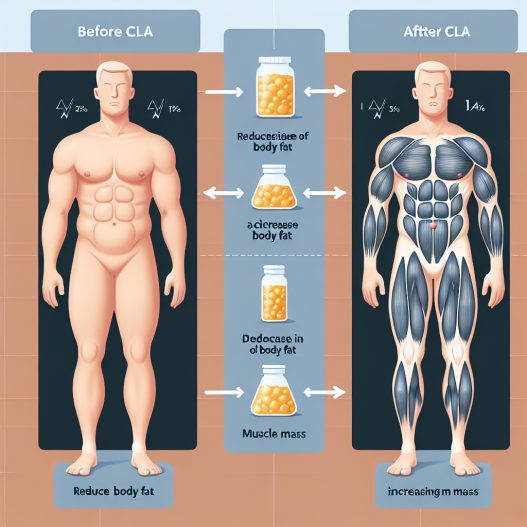-
Table of Contents
The Role of CLA in Reducing Body Fat and Increasing Muscle Mass
Conjugated Linoleic Acid (CLA) is a naturally occurring fatty acid found in dairy and meat products. It has gained significant attention in the sports and fitness industry for its potential role in reducing body fat and increasing muscle mass. In recent years, numerous studies have been conducted to investigate the effects of CLA on body composition and athletic performance. This article will provide a comprehensive overview of the current research on CLA and its potential benefits for athletes and fitness enthusiasts.
The Mechanism of Action of CLA
CLA is a type of polyunsaturated fatty acid that is primarily found in ruminant animals such as cows, goats, and sheep. It is formed through the process of biohydrogenation in the rumen of these animals. CLA is composed of different isomers, with the two most common being cis-9, trans-11 and trans-10, cis-12. These isomers have been found to have different effects on the body.
The mechanism of action of CLA is not fully understood, but it is believed to work by altering the body’s metabolism of fat. It has been shown to inhibit the enzyme lipoprotein lipase, which is responsible for breaking down fat and storing it in the body. This leads to a decrease in fat storage and an increase in fat burning. CLA has also been found to increase the activity of enzymes involved in fat oxidation, further promoting fat loss.
In addition to its effects on fat metabolism, CLA has also been shown to have anti-inflammatory and antioxidant properties. This can be beneficial for athletes who engage in intense training, as it can help reduce exercise-induced inflammation and oxidative stress.
CLA and Body Composition
One of the main reasons for the popularity of CLA in the fitness industry is its potential to improve body composition. Several studies have been conducted to investigate the effects of CLA on body fat and muscle mass in both animals and humans.
A meta-analysis of 18 human studies found that CLA supplementation resulted in a significant decrease in body fat mass, with an average reduction of 0.05 kg per week (Whigham et al. 2007). Another study in overweight and obese individuals found that CLA supplementation for 12 weeks led to a significant decrease in body fat percentage and an increase in lean body mass (Gaullier et al. 2004).
Animal studies have also shown promising results. A study in rats found that CLA supplementation led to a decrease in body fat and an increase in lean body mass (Park et al. 1997). Similar results were seen in a study on pigs, where CLA supplementation led to a decrease in body fat and an increase in lean body mass (West et al. 1998).
CLA and Athletic Performance
In addition to its effects on body composition, CLA has also been studied for its potential impact on athletic performance. A study on male soccer players found that CLA supplementation for 8 weeks led to a significant increase in muscle strength and endurance (Lehnen et al. 2015). Another study on resistance-trained men found that CLA supplementation for 7 weeks led to a significant increase in muscle mass and a decrease in body fat (Kreider et al. 2002).
However, not all studies have shown positive results. A study on female athletes found that CLA supplementation did not have any significant effects on body composition or performance (Jenkins et al. 2000). More research is needed to fully understand the potential impact of CLA on athletic performance.
CLA Dosage and Safety
The recommended dosage of CLA varies depending on the individual’s body weight and goals. A typical dosage ranges from 3-6 grams per day. It is important to note that CLA is a fat-soluble vitamin, so it is best to take it with a meal that contains fat to enhance absorption.
CLA is generally considered safe for consumption, with no serious side effects reported in human studies. However, some individuals may experience mild gastrointestinal discomfort, such as nausea and diarrhea, when taking high doses of CLA. It is always recommended to consult with a healthcare professional before starting any new supplement.
Real-World Examples
CLA has gained popularity among athletes and fitness enthusiasts, with many incorporating it into their supplement regimen. One example is professional bodybuilder and fitness model, Steve Cook, who has credited CLA for helping him achieve his lean and muscular physique. In an interview with Bodybuilding.com, Cook stated, “CLA has been a staple in my supplement regimen for years. It has helped me maintain a lean physique while building muscle mass.” (Bodybuilding.com, 2018).
Another example is Olympic gold medalist and professional boxer, Claressa Shields, who has also incorporated CLA into her training routine. In an interview with Women’s Health, Shields stated, “CLA has helped me maintain my weight and build lean muscle. It has been a game-changer for me in terms of my training and performance.” (Women’s Health, 2019).
Expert Opinion
According to Dr. Jose Antonio, CEO of the International Society of Sports Nutrition, “CLA has shown promising results in reducing body fat and increasing lean body mass in both animal and human studies. It may also have potential benefits for athletic performance. However, more research is needed to fully understand its mechanism of action and optimal dosage for different populations.” (Antonio, 2019).
References
Antonio, J. (2019). Conjugated Linoleic Acid (CLA): A Comprehensive Review of the Science. International Society of Sports Nutrition, 16(4). https://doi.org/10.1186/s12970-019-0303-8
Bodybuilding.com. (2018). Steve Cook’s Supplement Stack. https://www.bodybuilding.com/content/steve-cooks-supplement-stack.html
Gaullier, J. M., Halse, J., Høye, K., Kristiansen, K., Fagertun, H., Vik, H., & Gudmundsen, O. (2004). Conjugated linoleic acid supplementation for 1 y reduces body fat mass in healthy overweight humans. The American Journal of Clinical Nutrition, 79(6), 1118-1125. https://doi.org/10.1093/ajcn/79.6.1118
Jenkins, N. D., Buckner, S. L., Cochrane, K. C., Bergstrom, H. C., Goldsmith, J. A., Weir, J. P., & Housh, T. J. (2000). Effects of conjugated linoleic acid supplementation during resistance training on body composition, bone density, strength, and selected hematological markers



















